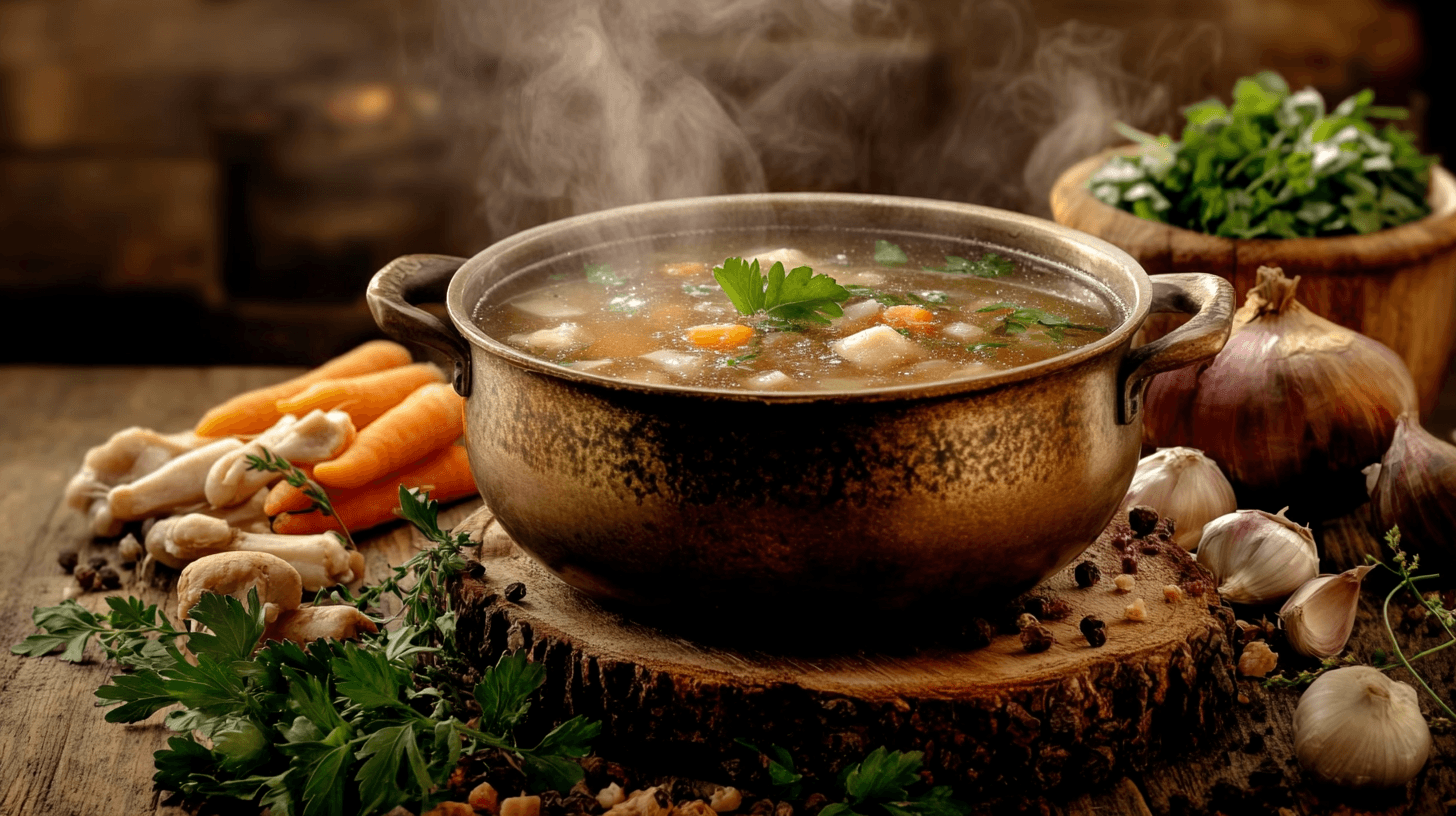
Bone Broth
Bone Broth is a nutrient-dense, savory liquid made by slowly simmering animal bones (and optionally their connective tissues) with vegetables, herbs, and spices. This traditional broth is renowned for its rich flavor, collagen content, and health benefits—making it a popular base for soups, stews, and sauces or simply enjoyed on its own as a nourishing beverage.
Equipment
- Large Stockpot, Slow Cooker, or Pressure Cooker: For long, slow simmering.
- Roasting Pan: (Optional) To roast bones for added depth of flavor.
- Fine Mesh Strainer or Cheesecloth: For straining the broth.
- Cutting Board and Knife: For prepping vegetables.
- Tongs and Ladle: For handling bones and skimming impurities.
- Storage Containers: For refrigerating or freezing the finished broth.
Ingredients
- Bones: 2–3 lbs of bones beef, chicken, turkey, or fish – choose based on preference
- Apple Cider Vinegar: 1–2 tablespoons helps extract minerals from bones
- Water: Approximately 10–12 cups or enough to cover the bones by about 1 inch
- Onion: 1 large quartered (skin on for extra color is optional)
- Carrots: 2 medium roughly chopped
- Celery: 2 stalks roughly chopped
- Garlic: 4 cloves lightly smashed
- Bay Leaf: 1 large
- Black Peppercorns: 1 teaspoon whole
- Herbs Optional: A few sprigs of thyme and/or rosemary
- Salt: To taste preferably added after cooking to control sodium levels
Instructions
- (Optional) Roast the Bones:
- Preheat your oven to 400°F (200°C).
- Place the bones in a roasting pan and roast for 30–45 minutes until they are well-browned. This step enhances the flavor and adds richness to the broth.
- Prepare the Broth Base:
- Transfer the roasted (or raw) bones to your large stockpot, slow cooker, or pressure cooker.
- Add the apple cider vinegar and enough water to cover the bones by about 1 inch.
- Let the mixture sit for 20–30 minutes to allow the vinegar to help draw minerals from the bones.
- Add Vegetables and Seasonings:
- Add the quartered onion, chopped carrots, celery, garlic, bay leaf, and black peppercorns.
- Include optional herbs like thyme or rosemary if using.
- Simmer the Broth:
- Stovetop/Slow Cooker: Bring the mixture to a boil over medium-high heat, then reduce to a very low simmer. Skim off any foam or impurities that rise to the top during the first 30 minutes of simmering.
- Cooking Duration:
- Beef Bones: Simmer for 12–24 hours.
- Poultry Bones: Simmer for 8–12 hours.
- Fish Bones: Simmer for 4–6 hours.
- Pressure Cooker Option: Cook on high pressure for about 2–3 hours for a quicker version (adjust liquid levels as needed).
- Strain and Cool:
- Once finished, remove large bones and vegetables using a slotted spoon.
- Strain the broth through a fine mesh strainer (or cheesecloth-lined sieve) into another pot or large heat-proof container.
- Allow the broth to cool to room temperature.
- Store or Serve:
- Refrigerate the broth overnight. Once chilled, a layer of fat will solidify on top—this can be removed or stirred back in, according to preference.
- The broth can be stored in the refrigerator for up to 5 days or frozen in portions for several months.
- Details
- Prep Time: 20–30 minutes (plus an optional 30–45 minutes for roasting bones)
- Cook Time:
- Beef: 12–24 hours
- Poultry: 8–12 hours
- Fish: 4–6 hours
- (Alternatively, 2–3 hours in a pressure cooker)
- Time Total: Approximately 13–24+ hours (depending on the type of bones and cooking method)
- Yield: About 8–12 cups of broth
- Category: Soup, Stock, Broth
- Method: Slow Simmering / Pressure Cooking
- Cuisine: Traditional, Universal
- Diet: Paleo, Keto, Whole30, Gluten-Free
- Keywords
- bone broth, homemade broth, slow-cooked, stock, collagen, healthy, paleo, keto, whole30, nutrient-dense
- Nutrition (Per Serving – Approx. 1 Cup / 240 ml)
- Note: Nutritional values are approximate and can vary based on the bones and ingredients used.
- Calories: 50–80 kcal
- Sugar: 1–2 g
- Sodium: 100–200 mg (without added salt)
- Fat: 2–4 g
- Saturated Fat: ~1 g
- Unsaturated Fat: 1–3 g
- Trans Fat: 0 g
- Carbohydrates: 2–4 g
- Fiber: 0–1 g
- Protein: 5–10 g
- Cholesterol: 10–20 mg
Notes
Flavor Boosters: Roasting the bones is optional but highly recommended for a deeper, richer flavor.
Skimming: Regularly skim off foam and impurities during the first 30 minutes of simmering for a cleaner-tasting broth.
Storage Tip: For a clearer broth, let it cool undisturbed and remove the solidified fat layer from the top before reheating.
Customizations: Feel free to experiment with additional herbs (like parsley) or spices (such as ginger) based on your taste preferences.
Health Benefits: Bone broth is celebrated for its collagen content, amino acids, and minerals, which may support joint health, digestion, and skin.
Skimming: Regularly skim off foam and impurities during the first 30 minutes of simmering for a cleaner-tasting broth.
Storage Tip: For a clearer broth, let it cool undisturbed and remove the solidified fat layer from the top before reheating.
Customizations: Feel free to experiment with additional herbs (like parsley) or spices (such as ginger) based on your taste preferences.
Health Benefits: Bone broth is celebrated for its collagen content, amino acids, and minerals, which may support joint health, digestion, and skin.